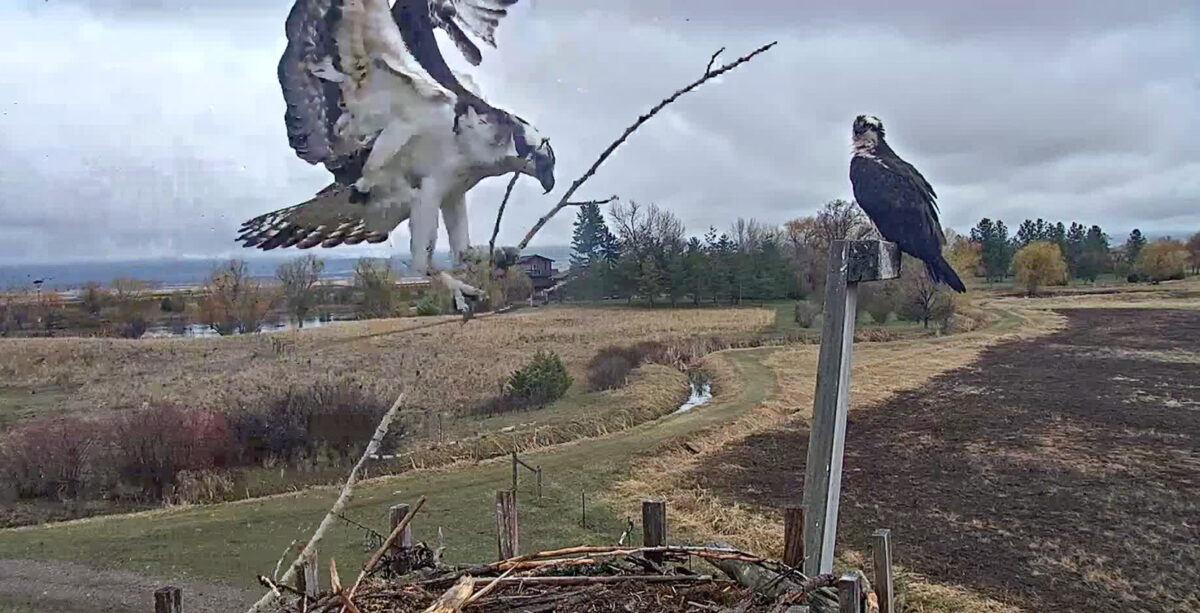Mission Valley Osprey Camera Captivates Global Audience
The recent return of osprey pair Charlie and Charlotte to their Charlo nest coincides with a bailing-twine cleanup campaign organized by the Owl Research Institute
By Tristan Scott
The most famous reality-television stars you’ve never heard of might just be Charlie and Charlotte, of Charlo, an osprey pair who each spring for at least seven years have alighted on a raised nesting platform overlooking the expansive Mission Valley, where researchers with the Owl Research Institute (ORI) have installed live cameras to stream 24/7 observations.
No one knows for sure where the couple spends its winters, except that they’re almost certainly sunbathing somewhere between northern Mexico and the southern tip of South America. But once they migrate back to Charlo every April, the pair gets straight to work, collecting materials for their nest, catching fish out of the nearby Flathead River and copulating.
And they do it in front of a global audience.

Since 2012, the Owl Research Institute has partnered with Explore.org, an arm of the Annenberg Foundation, to share not only owls and owl behavior with the rest of the world, but also that of the resident osprey who frequent the nearby Flathead River. The institute’s three live cameras allow nighttime observations with infrared lighting and have attracted viewers in every country, generating 4.5 million page views that represented 2.7 million independent page views.
“It’s like a soap opera,” Lauren Smith, ORI’s communications and development director, said. “The Charlo Osprey Cam has a very dedicated audience that tracks their every movement.”
Indeed, thousands of viewers narrate the osprey opera playing out on their computer screens, with observations ranging from the banal — “stick delivery!” or “Charlie delivers nesting materials” — to the besotted — “I love how much time they spend together. They really seem to have such a strong bond.”
Osprey are a monogamous species and tend to mate for life, and while Charlie and Charlotte aren’t banded birds and researchers have no way of knowing for certain if the same pair returns year after year, viewers are insistent.
This week, the researchers and the online commentators cheered the pair’s homecoming, welcoming Charlotte on April 17, and Charlie two days later, just in time for ORI’s inaugural Bailing Twine Cleanup Week, an Earth Day event that encourages bird-watchers and local residents to collect scraps of bailing twine and other bits of litter that the osprey might use as lining in their nests. Adults and chicks can become tangled in the debris, which leads to serious and often fatal injury.

“We have seen this first-hand with our local pair,” Smith said. “In 2021, one of the two osprey chicks on the Charlo nest died because it became entangled in baling twine. In 2022, to the horror of live-cam viewers, including myself, the female osprey became tangled and spent several minutes dangling from the nest platform before she was able to free herself. Most are not this lucky, and it is not uncommon to find osprey carcasses caught up in twine.”

In an effort to raise awareness, ORI is asking residents to pick up twine and litter in the area and drop it off either at ORI’s headquarters in Charlo or at the Confederated Salish and Kootenai Tribes’ wildlife office in Polson. Anyone not local to the area can properly dispose of the twine or litter they collect and post a picture to social media.
“As an incentive, everyone who tags ORI will be entered into a drawing for small prizes donated by local businesses, such as gift cards or baskets and ORI swag,” Smith said.
The contest runs through Earth Day on April 22. Like or follow ORI on Facebook, Twitter and Instagram.
“We’re trying to do what we can to raise awareness and help protect these amazing birds,” Smith said.
For more than 35 years, the Owl Research Institute has operated out of a converted farmhouse at the foot of the Mission Mountains, flanking the Ninepipe National Wildlife Refuge, under the tutelage of Denver Holt, known throughout the international ornithological community as “Mr. Owl.” His meticulous research has informed some of the most in-depth, long-term studies of owls and owl behavior on record, while his efforts to share raptor research with the rest of the world has extended to the Charlo Osprey Camera.
“Obviously, these cams enable us to bring our message and educational programs to a large audience,” Holt told the Beacon in a 2017 interview.